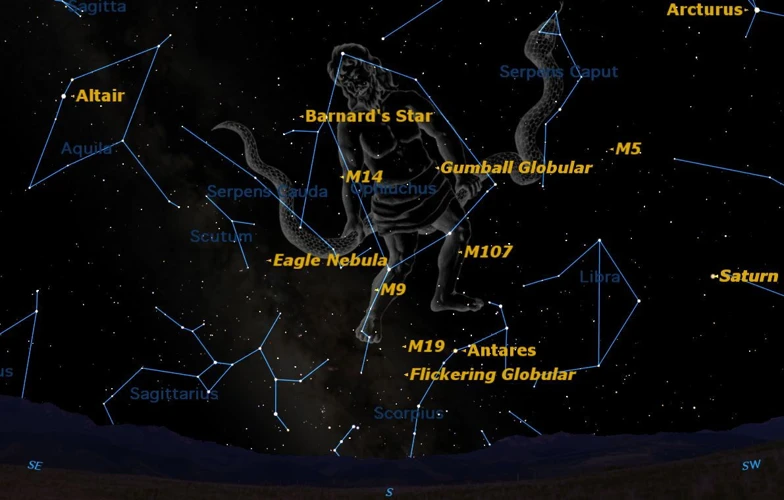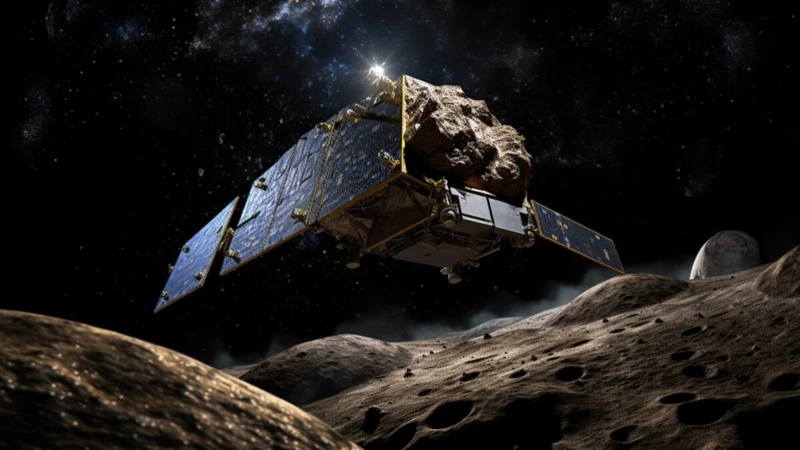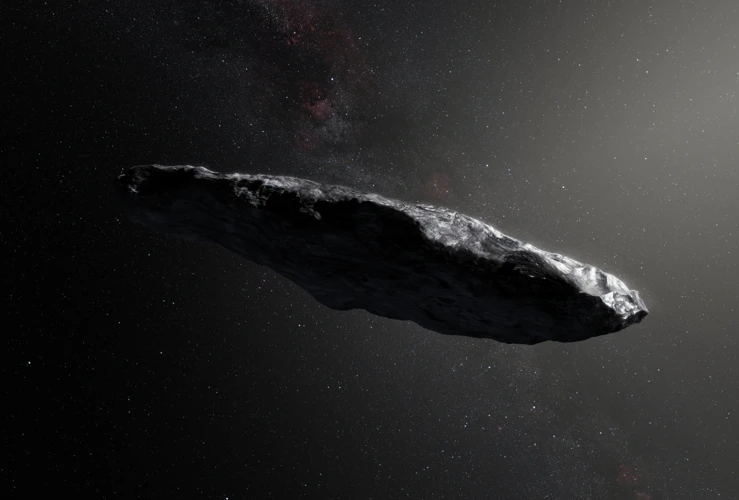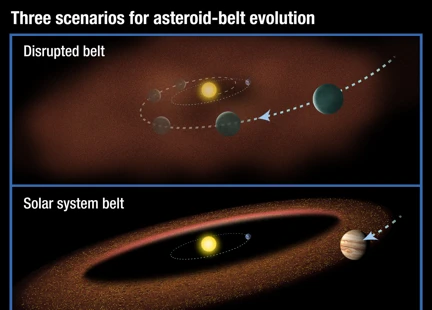It is a question that has captivated the human imagination for centuries: are we alone in the universe? Although the search for extraterrestrial life continues to captivate scientists and enthusiasts alike, the potential for life beyond Earth remains an enigma. One area of exploration that has shown promise is the study of asteroids, small celestial bodies that orbit the Sun. With their diverse composition and the presence of potentially life-sustaining elements, asteroids could hold the key to unlocking the mysteries of extraterrestrial life. In this article, we will delve into the world of asteroids and examine the conditions necessary for life to thrive. We will explore how the study of asteroids and the search for extraterrestrial life has shaped our understanding of the universe and our place within it.
Contents
- Overview of Asteroids
- Conditions for Life
- Clues from Asteroid Samples
- Potential for Microbial Life
- Impact on Panspermia Theory
- Extraterrestrial Implications
- Search for Extraterrestrial Intelligence
- Conclusion
-
Frequently Asked Questions
- 1. What are asteroids made of?
- 2. How big can asteroids get?
- 3. Where do asteroids come from?
- 4. How do asteroids differ from comets?
- 5. Can asteroids pose a threat to Earth?
- 6. How do scientists study asteroids?
- 7. Have we found any signs of extraterrestrial life on asteroids?
- 8. Can asteroids provide resources for human exploration?
- 9. How are asteroids named?
- 10. What is the difference between an asteroid and a meteoroid?
- References
-
Frequently Asked Questions
- 1. Can asteroids support life?
- 2. Are there any signs of water on asteroids?
- 3. What are organic compounds, and why are they important for life?
- 4. How do asteroids provide energy sources for life?
- 5. Have scientists found any evidence of life in asteroid samples?
- 6. What do volatile compounds reveal about asteroids?
- 7. How can the identification of biomolecules in asteroid samples be significant?
- 8. Is there a possibility of microbial life on asteroids?
- 9. What is the impact of asteroids on the panspermia theory?
- 10. How does the search for extraterrestrial intelligence relate to asteroids?
- References
- Read More
Overview of Asteroids

Asteroids are fascinating celestial objects that orbit the Sun, primarily found in the asteroid belt between Mars and Jupiter. They are remnants from the early formation of our solar system and provide valuable insights into the history and composition of the universe. These rocky bodies vary in size, ranging from small boulders to massive asteroids several hundred kilometers in diameter. Interestingly, scientists have identified over a million asteroids, each with unique characteristics and compositions. Some asteroids are rich in metals, such as iron and nickel, while others contain organic compounds and volatile elements. Their diverse nature makes asteroids a valuable source of information for scientists studying the potential for extraterrestrial life. By studying asteroids, scientists can gain insights into the building blocks of life and the conditions required for it to exist. This knowledge can contribute to our understanding of the broader universe and the possibilities of life beyond our planet. To truly comprehend the significance of asteroids in the search for extraterrestrial life, it is essential to explore their composition and the clues they may hold about the origins of life in the universe.
Conditions for Life

Three key conditions are necessary for the existence of life: water presence, organic compounds, and energy sources. Water is the foundation of life as we know it, and its presence is crucial for the development and sustainability of living organisms. Organic compounds, such as amino acids, nucleotides, and lipids, are the building blocks of life. They provide the necessary chemical components for the formation of complex biological structures. Energy sources, on the other hand, are vital for driving the metabolic processes that sustain life. This energy can come from a variety of sources, including sunlight, chemical reactions, or geothermal activity. Combining these three essential factors creates the potential for life to thrive in various environments. Scientists believe that if these conditions are met, the possibility of extraterrestrial life becomes more plausible. By exploring asteroids and their composition, we can gain valuable insights into these conditions and expand our understanding of the potential for life beyond Earth.
1. Water Presence
Water is a vital ingredient for the existence of life as we know it. In the search for extraterrestrial life, one of the key factors scientists consider is the presence of water on celestial bodies. When it comes to asteroids, the presence of water is of particular interest. Various studies have provided evidence suggesting the presence of water ice on asteroids. This finding is significant, as water can serve as a potential habitat for microbial life. Researchers believe that water on asteroids may have originated from comets or even be indigenous to the asteroids themselves. The discovery of hydrated minerals and water ice in samples collected from asteroids supports this theory. Scientists hypothesize that asteroids may have acted as “water delivery systems” by transporting water to other regions of the solar system, including Earth. This concept, known as panspermia, proposes that the seeds of life may have been spread throughout the universe via asteroids. The presence of water on asteroids offers tantalizing possibilities and underscores the importance of continued research to unravel the mysteries surrounding the potential for extraterrestrial life.
2. Organic Compounds
Organic compounds play a crucial role in the search for extraterrestrial life, as they are the building blocks of life as we know it. These compounds are composed primarily of carbon and hydrogen, along with other elements like nitrogen, oxygen, and sulfur. Scientists believe that the presence of organic compounds on asteroids could provide valuable insights into the origins of life on Earth and the potential for life elsewhere in the universe.
One of the most significant discoveries related to organic compounds on asteroids came from the analysis of meteorites that have fallen to Earth. These meteorites, believed to originate from asteroids, contain a wide variety of organic compounds, including amino acids, the building blocks of proteins. The presence of such complex molecules supports the hypothesis that asteroids could have delivered the ingredients necessary for life to Earth during its early stages of formation.
The study of organic compounds found on asteroids also provides clues about the chemical processes that occurred during the early formation of the solar system. By analyzing the composition and structure of these compounds, scientists can gain insights into the environments where they formed and the potential for similar conditions to exist elsewhere in the universe. The identification of specific organic compounds on asteroids opens up possibilities for understanding the potential habitability of other celestial bodies and the likelihood of finding extraterrestrial life.
In recent years, technological advancements have allowed scientists to detect and analyze organic compounds directly on asteroids using space missions. For example, NASA’s OSIRIS-REx mission successfully collected a sample from the asteroid Bennu and is expected to provide valuable data about the organic compounds present on its surface. These missions contribute to our understanding of the prevalence and distribution of organic compounds in the solar system, enhancing our ability to identify locations with the potential for supporting life.
The presence of organic compounds on asteroids is a significant area of study in the search for extraterrestrial life. These compounds offer insights into the origins of life on Earth and the possibility of life beyond our planet. By studying the composition and distribution of organic compounds on asteroids, scientists gain a better understanding of the conditions necessary for life to emerge and thrive elsewhere in the universe. This knowledge brings us one step closer to unraveling the mysteries of our existence and the potential for life among the stars.
3. Energy Sources
When considering the potential for extraterrestrial life, one crucial factor to examine is the availability of energy sources. Energy is essential for the sustenance of life, as it drives various biological processes and enables the existence of complex organisms. In the case of asteroids, energy sources can take different forms. One such source is solar energy, which is abundant in the asteroid belt. As asteroids orbit the Sun, they receive sunlight, and this energy can be harnessed by potential life forms for photosynthesis or other metabolic processes. Solar energy provides a fundamental source of power for sustaining life as we know it. Another potential energy source on asteroids is the presence of radioactive materials. These radioactive elements can undergo decay, releasing energy in the process. This energy could be utilized by organisms for various purposes, just as some extremophiles on Earth derive energy from radioactive substances. The availability of energy sources on asteroids is a crucial factor in determining the potential habitability and the presence of extraterrestrial life. By understanding the energy dynamics and exploring the possibilities of different energy sources, scientists can gain insights into the viability of life beyond Earth and expand our understanding of the universe.
Clues from Asteroid Samples

Studying samples obtained from asteroids is a critical aspect of understanding their hidden secrets and potential for extraterrestrial life. Through meticulous analysis of these samples, scientists can uncover valuable clues about the composition and history of asteroids, providing valuable insights into the possibility of life beyond Earth. One key area of study involves the analysis of volatile compounds found within asteroid samples. These volatile compounds, such as water and other volatile elements, can shed light on the presence of necessary ingredients for life to thrive. Additionally, the identification of biomolecules within asteroid samples can further support the hypothesis of extraterrestrial life. These biomolecules could be indicators of the existence of microbial life or serve as building blocks for more complex forms of life. By delving into the intricacies of asteroid samples, scientists can unlock the mysteries of the universe and potentially uncover evidence of extraterrestrial life.
1. Analysis of Volatile Compounds
Analysis of volatile compounds in asteroid samples provides valuable insights into the potential for extraterrestrial life. These compounds include elements such as carbon, nitrogen, hydrogen, and oxygen, which are crucial for the development and sustenance of living organisms. Scientists utilize various techniques to analyze these volatile compounds, including gas chromatography and mass spectrometry. Through these methods, they can identify the presence of organic molecules, such as amino acids and sugars, which are the building blocks of life as we know it. The discovery of organic compounds within asteroid samples ignites excitement among scientists as it suggests that the conditions necessary for life may exist beyond Earth. This information contributes to our understanding of the universe and the possibility of habitable environments on other celestial bodies. By studying the volatile compounds within asteroids, scientists can gather evidence to support the existence of extraterrestrial life and explore the potential for diverse ecosystems beyond our planet’s boundaries. The study of volatile compounds in asteroids bridges the gap between the search for extraterrestrial life and the understanding of the origins and evolution of life in the universe.
2. Identification of Biomolecules
Identification of biomolecules is a crucial aspect of studying asteroids for potential extraterrestrial life. Biomolecules, such as amino acids, nucleotides, and lipids, are the building blocks of life as we know it. Scientists analyze asteroid samples to determine if these biomolecules are present, as their existence could indicate the possibility of past or even current life beyond Earth. The identification of biomolecules in asteroids has been a subject of extensive research and has yielded fascinating results. For example, in 2010, a team of scientists found the presence of amino acids in the samples collected from the asteroid called Itokawa. This discovery provided compelling evidence that the ingredients necessary for life may be present in asteroids. The identification of biomolecules can provide insights into the chemical processes that occur in asteroids and the potential for the development and evolution of life. By understanding the types and quantities of biomolecules present in asteroids, scientists can gain valuable knowledge about the potential habitats for extraterrestrial life and the conditions necessary for its existence. The identification of biomolecules in asteroids not only deepens our understanding of the possibility of life beyond Earth but also has implications for astrobiology and the search for life on other celestial bodies within our own solar system and beyond.
Potential for Microbial Life

The potential for microbial life within asteroids is a captivating area of exploration. Microbes, being simple and adaptable organisms, have shown incredible resilience in extreme environments on Earth, leading scientists to speculate about their potential existence in asteroids. One possibility is that microbial life could have hitchhiked on asteroids, surviving within protective layers or dormant states during interplanetary travel. Once these asteroids reach suitable environments, such as planets or moons with appropriate conditions, these microorganisms could potentially awaken and thrive. This concept, known as panspermia, raises intriguing questions about the possibility of life originating from outside our planet. Recent research has provided evidence that certain types of bacteria and fungi can survive and even thrive in the harsh conditions found within asteroids. These organisms have shown the ability to withstand extreme temperatures, radiation, and the vacuum of space. Additionally, experiments on the International Space Station have revealed that microorganisms can survive on the exterior surface of the station, further supporting the notion that microbial life could exist within asteroids. While the existence of microbial life within these celestial bodies remains hypothetical, ongoing research and future space exploration missions may provide us with more concrete answers. Exploring the potential for microbial life in asteroids not only deepens our understanding of the origins of life but also raises intriguing questions about the possibilities of life beyond our planet.
Impact on Panspermia Theory

The study of asteroids has a profound impact on the theory of panspermia. Panspermia suggests that life on Earth could have originated from microorganisms or organic molecules hitchhiking on asteroids, comets, or other celestial bodies and then being delivered to our planet. This theory raises intriguing questions about the potential for extraterrestrial life, as it suggests that life may not have independently originated on Earth but rather arrived from elsewhere in the universe. By examining the composition of asteroids, scientists can investigate whether they contain evidence of microbial life or organic molecules that could have played a role in seeding life on Earth. Additionally, the discovery of specific biomolecules or complex organic compounds on asteroids would provide substantial support for the panspermia theory. While conclusive evidence has yet to be found, ongoing studies of asteroids and the analysis of their samples bring us closer to understanding our cosmic origins and the potential interconnectedness of life throughout the universe. The impact of asteroids on the panspermia theory opens up a realm of possibilities for the existence of extraterrestrial life and our own place in the vast cosmos.
Extraterrestrial Implications

The implications of the existence of extraterrestrial life are profound and far-reaching. The discovery of life beyond Earth would revolutionize our understanding of the universe and our place in it. Firstly, it would provide strong evidence that life can arise in different environments, expanding the possibilities for habitable zones in the cosmos. This, in turn, would increase the likelihood of finding life on other celestial bodies, such as Mars or the moons of Jupiter and Saturn. The discovery of extraterrestrial life could have significant philosophical and religious implications, challenging long-held beliefs and sparking new debates about our origins and purpose. The technological advancements required to detect and communicate with extraterrestrial life would also have practical applications on Earth, leading to breakthroughs in various fields of science and technology. The discovery of extraterrestrial life would stimulate space exploration and colonization efforts, as we seek to study and interact with newfound forms of life. As we ponder the extraterrestrial implications, it is essential to remember that the search for extraterrestrial life encompasses not only the quest for biological organisms but also the exploration of microbial life and the existence of intelligent civilizations elsewhere in the universe. It is a journey that continues to captivate the human imagination and push the boundaries of our knowledge.
Search for Extraterrestrial Intelligence

In the quest to unravel the mysteries of extraterrestrial life, scientists have embarked on the ambitious endeavor known as the Search for Extraterrestrial Intelligence (SETI). SETI aims to detect signs of intelligent civilizations beyond Earth by scanning the vast expanse of space for signals that may indicate the presence of technologically advanced beings. This groundbreaking initiative involves the use of advanced radio telescopes and signal processing techniques to analyze the cosmic microwave background and radio frequencies emitted by distant celestial bodies. The search for extraterrestrial intelligence is not limited to radio signals alone; it also encompasses the exploration of other potential communication mediums, such as laser pulses and interstellar beacons. While the search has yet to yield conclusive evidence of intelligent life, it continues to capture the imagination of scientists and the public alike. The possibility of making contact with an extraterrestrial civilization has spurred numerous theories and speculations about their nature and intentions. Through ongoing research and advancements in technology, the search for extraterrestrial intelligence remains an exciting and ever-evolving field of study. Whether we ultimately discover signs of intelligent life or not, the quest for answers will continue to drive our curiosity and expand our understanding of the vast universe we inhabit.
Conclusion

In conclusion, the study of asteroids and their potential for extraterrestrial life opens up a world of possibilities. Through the examination of their composition and the analysis of volatile compounds and biomolecules, scientists can gain valuable insights into the conditions necessary for life to exist beyond Earth. While the search for extraterrestrial life is ongoing, asteroids provide valuable clues about the building blocks of life and the potential for microbial organisms. Furthermore, the concept of panspermia, the idea that life can be spread through space by asteroids, adds another layer of intrigue to the exploration of these celestial bodies. As we continue to unravel the mysteries of the universe, the study of asteroids and their implications for extraterrestrial life will undoubtedly remain a captivating and evolving field of research. To delve deeper into the fascinating realm of space exploration and our understanding of the cosmos, check out our article on the role of dragons in Chinese mythology and culture.
Frequently Asked Questions

1. What are asteroids made of?
Asteroids are primarily made up of rocky materials such as silicate minerals, metals like iron and nickel, as well as organic compounds. The composition of asteroids can vary depending on their location in the solar system and their formation history.
2. How big can asteroids get?
Asteroids can range in size from a few meters to hundreds of kilometers in diameter. The largest known asteroid, Ceres, has a diameter of about 940 kilometers.
3. Where do asteroids come from?
Asteroids are believed to be remnants from the early stages of the formation of our solar system, often referred to as the protoplanetary disk. They are thought to be the building blocks that never formed into full-sized planets.
4. How do asteroids differ from comets?
Asteroids and comets are similar in that they are both celestial bodies orbiting the Sun, but they have distinct differences. Asteroids are mainly composed of rocky or metallic materials, while comets are made up of ice, dust, and organic compounds. Comets also tend to have more elongated orbits compared to asteroids.
5. Can asteroids pose a threat to Earth?
While the vast majority of asteroids pose no direct threat to Earth, there is a small possibility of a potentially hazardous asteroid colliding with our planet. Scientists actively monitor and track these near-Earth asteroids to assess their potential impact risks.
6. How do scientists study asteroids?
Scientists study asteroids through various methods, including space missions, telescopic observations, and analysis of meteorites that have fallen to Earth. Space missions like NASA’s OSIRIS-REx and Japan’s Hayabusa2 have collected samples from asteroids and returned them to Earth for in-depth analysis.
7. Have we found any signs of extraterrestrial life on asteroids?
While no definitive signs of extraterrestrial life have been found on asteroids, scientists have discovered organic compounds on some asteroids, which are fundamental building blocks for life as we know it. These findings hint at the potential for life beyond Earth.
8. Can asteroids provide resources for human exploration?
Yes, asteroids have gained interest for their potential as sources of valuable resources such as water, metals, and minerals. The concept of asteroid mining has been proposed as a means to extract these resources for future human exploration and even for space-based industries.
9. How are asteroids named?
Asteroids are typically named after people, places, or characters from mythology. The International Astronomical Union (IAU) oversees the naming process and ensures that no duplicate names are given to different objects.
10. What is the difference between an asteroid and a meteoroid?
An asteroid is a larger celestial body that orbits the Sun and is generally composed of rocky or metallic materials. A meteoroid, on the other hand, is a smaller object, typically ranging from a grain to a few meters in size, that also orbits the Sun. When a meteoroid enters the Earth’s atmosphere and burns up, it is referred to as a meteor.
References
Frequently Asked Questions

1. Can asteroids support life?
While asteroids themselves don’t have the necessary conditions to support complex life forms, they can potentially carry the building blocks of life. Let’s explore further.
2. Are there any signs of water on asteroids?
Yes, recent research suggests that water may exist in the form of ice on some asteroids. This discovery has raised the possibility of extraterrestrial life existing within these celestial bodies.
3. What are organic compounds, and why are they important for life?
Organic compounds are complex molecules that contain carbon, hydrogen, and other elements. They are essential for the formation of life as we know it, serving as the basis for proteins, DNA, and other vital components of living organisms.
4. How do asteroids provide energy sources for life?
Asteroids can be rich in various minerals and metals that trap and store energy from the Sun. These resources could potentially be used by microorganisms as a source of energy for their survival and growth.
5. Have scientists found any evidence of life in asteroid samples?
While no direct evidence of life has been found in asteroid samples yet, scientists have discovered organic molecules and amino acids within these samples, hinting at the possibility of life beyond Earth.
6. What do volatile compounds reveal about asteroids?
By analyzing the volatile compounds found in asteroid samples, scientists can gain insights into the history and composition of these celestial bodies. This helps in understanding the potential for extraterrestrial life.
7. How can the identification of biomolecules in asteroid samples be significant?
The identification of biomolecules in asteroid samples could provide concrete evidence for the existence of life beyond Earth. It would support the theory that life can originate elsewhere in the universe and potentially be transported through space.
8. Is there a possibility of microbial life on asteroids?
Given the presence of water, organic compounds, and potential energy sources, it is plausible that microbial life could exist or have existed on asteroids. Further exploration and analysis are needed to confirm this possibility.
9. What is the impact of asteroids on the panspermia theory?
Asteroids play a significant role in the panspermia theory, which suggests that life could have originated on one planet or moon and then spread to others through asteroid impacts. The discovery of life on asteroids could support this theory and change our understanding of the origins of life.
10. How does the search for extraterrestrial intelligence relate to asteroids?
Studying asteroids and the potential for extraterrestrial life helps in the broader quest to find signs of intelligent life beyond Earth. By understanding the conditions necessary for life, we can better target our search for extraterrestrial intelligence.







